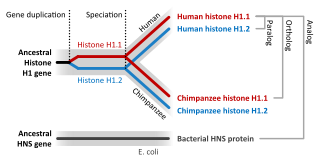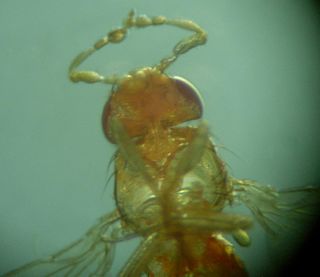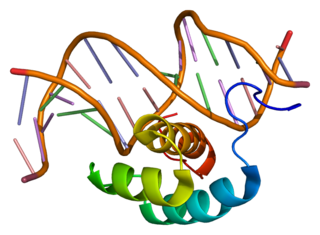Related Research Articles

A homeobox is a DNA sequence, around 180 base pairs long, that regulates large-scale anatomical features in the early stages of embryonic development. Mutations in a homeobox may change large-scale anatomical features of the full-grown organism.

Sequence homology is the biological homology between DNA, RNA, or protein sequences, defined in terms of shared ancestry in the evolutionary history of life. Two segments of DNA can have shared ancestry because of three phenomena: either a speciation event (orthologs), or a duplication event (paralogs), or else a horizontal gene transfer event (xenologs).
Hox genes, a subset of homeobox genes, are a group of related genes that specify regions of the body plan of an embryo along the head-tail axis of animals. Hox proteins encode and specify the characteristics of 'position', ensuring that the correct structures form in the correct places of the body. For example, Hox genes in insects specify which appendages form on a segment, and Hox genes in vertebrates specify the types and shape of vertebrae that will form. In segmented animals, Hox proteins thus confer segmental or positional identity, but do not form the actual segments themselves.

Antennapedia is a Hox gene first discovered in Drosophila which controls the formation of legs during development. Loss-of-function mutations in the regulatory region of this gene result in the development of the second leg pair into ectopic antennae. By contrast gain-of-function alleles convert antennae into ectopic legs.

A gene cluster is a group of two or more genes found within an organism's DNA that encode similar polypeptides or proteins which collectively share a generalized function and are often located within a few thousand base pairs of each other. The size of gene clusters can vary significantly, from a few genes to several hundred genes. Portions of the DNA sequence of each gene within a gene cluster are found to be identical; however, the protein encoded by each gene is distinct from the proteins encoded by the other genes within the cluster. Gene clusters often result from expansions of a single gene caused by repeated duplication events, and may be observed near one another on the same chromosome or on different, but homologous chromosomes. An example of a gene cluster is the Hox gene, which is made up of eight genes and is part of the Homeobox gene family.
The 2R hypothesis or Ohno's hypothesis, first proposed by Susumu Ohno in 1970, is a hypothesis that the genomes of the early vertebrate lineage underwent two whole genome duplications, and thus modern vertebrate genomes reflect paleopolyploidy. The name derives from the 2 rounds of duplication originally hypothesized by Ohno, but refined in a 1994 version, and the term 2R hypothesis was probably coined in 1999. Variations in the number and timings of genome duplications typically still are referred to as examples of the 2R hypothesis.

Homeobox protein CDX-2 is a protein that in humans is encoded by the CDX2 gene. The CDX-2 protein is a homeobox transcription factor expressed in the nuclei of intestinal epithelial cells, playing an essential role in the development and function of the digestive system. CDX2 is part of the ParaHox gene cluster, a group of three highly conserved developmental genes present in most vertebrate species. Together with CDX1 and CDX4, CDX2 is one of three caudal-related genes in the human genome.

PDX1, also known as insulin promoter factor 1, is a transcription factor in the ParaHox gene cluster. In vertebrates, Pdx1 is necessary for pancreatic development, including β-cell maturation, and duodenal differentiation. In humans this protein is encoded by the PDX1 gene, which was formerly known as IPF1. The gene was originally identified in the clawed frog Xenopus laevis and is present widely across the evolutionary diversity of bilaterian animals, although it has been lost in evolution in arthropods and nematodes. Despite the gene name being Pdx1, there is no Pdx2 gene in most animals; single-copy Pdx1 orthologs have been identified in all mammals. Coelacanth and cartilaginous fish are, so far, the only vertebrates shown to have two Pdx genes, Pdx1 and Pdx2.

Homeobox protein Hox-D13 is a protein that in humans is encoded by the HOXD13 gene. This gene belongs to the homeobox family of genes. The homeobox genes encode a highly conserved family of transcription factors that play an important role in morphogenesis in all multicellular organisms.

Homeobox protein Hox-A7 is a protein that in humans is encoded by the HOXA7 gene.

Homeobox protein Hox-C13 is a protein that in humans is encoded by the HOXC13 gene.
Homeotic genes are genes which regulate the development of anatomical structures in various organisms such as echinoderms, insects, mammals, and plants. Homeotic genes often encode transcription factor proteins, and these proteins affect development by regulating downstream gene networks involved in body patterning.
The Cdx protein family is a group of the transcription factor proteins which bind to DNA to regulate the expression of genes. In particular this family of proteins can regulate the Hox genes. They are regulators of embryonic development and hematopoiesis in vertebrates, and are also involved in the development of some types of gastrointestinal cancers and leukemias.
Homeotic selector genes confer segment identity in Drosophila. They encode homeodomain proteins which interact with Hox and other homeotic genes to initiate segment-specific gene regulation. Homeodomain proteins are transcription factors that share a DNA-binding domain called the homeodomain. Changes in the expression and function of homeotic genes are responsible for the changes in the morphology of the limbs of arthropods as well as in the axial skeletons of vertebrates. Mutations in homeotic selector genes do not lead to elimination of a segment or pattern, but instead cause the segment to develop incorrectly.
The Gsx gene family are a group of genes found in many, but not all, animals. Gsx genes contain a homeobox DNA sequence and code for proteins that act as transcription factors. The human genome has two Gsx genes, called GSX1 and GSX2, while the fruitfly Drosophila has a single Gsx gene called ind. Vertebrate Gsx genes are implicated in neural patterning. In many animals, Gsx genes can be part of a ParaHox gene cluster.
The Cdx gene family, also called caudal genes, are a group of genes found in many animal genomes. Cdx genes contain a homeobox DNA sequence and code for proteins that act as transcription factors. The gene after which the gene family is named is the caudal or cad gene of the fruitfly Drosophila melanogaster. The human genome has three Cdx genes, called CDX1, CDX2 and CDX4. The zebrafish has no cdx2 gene, but two copies of cdx1 and one copy of cdx4. The Cdx gene in the nematode Caenorhabditis elegans is called pal-1.

ParaHoxozoa is a clade of animals that consists of Bilateria, Placozoa, and Cnidaria.

Hox genes play a massive role in some amphibians and reptiles in their ability to regenerate lost limbs, especially HoxA and HoxD genes.

Homeobox protein CDX-4 is a protein that in humans is encoded by the CDX4 gene. This gene is a member of the caudal-related homeobox transcription factor family that also includes CDX1 and CDX2.
Linda Zimmerman Holland is a research biologist at Scripps Institution of Oceanography known for her work examining the evolution of vertebrates.
References
- 1 2 Brooke, N.M.; Garcia-Fernandez, J.; Holland, P.W.H. (1998). "The ParaHox gene cluster is an evolutionary sister of the Hox gene cluster". Nature. 392 (6679): 920–922. Bibcode:1998Natur.392..920B. doi:10.1038/31933. PMID 9582071. S2CID 4398740.
- ↑ Ferrier, DE; Dewar, K; Cook, A; Chang, JL; Hill-Force, A; Amemiya, C (Oct 25, 2005). "The chordate ParaHox cluster". Current Biology. 15 (20): R820-2. Bibcode:2005CBio...15.R820F. doi: 10.1016/j.cub.2005.10.014 . PMID 16243016. S2CID 18638492.
- ↑ Pollard, Sophie L.; Holland, Peter W.H. (2000-09-01). "Evidence for 14 homeobox gene clusters in human genome ancestry". Current Biology. 10 (17): 1059–1062. Bibcode:2000CBio...10.1059P. doi: 10.1016/S0960-9822(00)00676-X . ISSN 0960-9822. PMID 10996074. S2CID 32135432.
- ↑ Mulley, J. F.; Holland, P. W. H. (11 May 2010). "Parallel Retention of Pdx2 Genes in Cartilaginous Fish and Coelacanths". Molecular Biology and Evolution. 27 (10): 2386–2391. doi:10.1093/molbev/msq121. PMC 2944030 . PMID 20463047.
- ↑ Hui, J; et al. (2008). "Do cnidarians have a ParaHox cluster? Analysis of synteny around a Nematostella homeobox gene cluster". Evolution & Development. 10 (6): 725–730. doi:10.1111/j.1525-142X.2008.00286.x. PMID 19021743. S2CID 31046327.
- ↑ Holland, P. W. H. (31 July 2001). "Beyond the Hox: how widespread is homeobox gene clustering?". Journal of Anatomy. 199 (1): 13–23. doi:10.1046/j.1469-7580.2001.19910013.x. PMC 1594991 . PMID 11523814.
- 1 2 Holland, P. W. H. (1 January 2012). "Evolution of homeobox genes". Wiley Interdisciplinary Reviews: Developmental Biology. 2 (1): 31–45. doi:10.1002/wdev.78. PMID 23799629. S2CID 44396110.
- ↑ Samadi, Leyli; Steiner, Gerhard (1 January 2010). "Conservation of ParaHox genes' function in patterning of the digestive tract of the marine gastropod Gibbula varia". BMC Developmental Biology. 10 (1): 74. doi: 10.1186/1471-213X-10-74 . PMC 2913954 . PMID 20624311.
- ↑ Pei, Z; Wang, B; Chen, G; Nagao, M; Nakafuku, M; Campbell, K (Jan 25, 2011). "Homeobox genes Gsx1 and Gsx2 differentially regulate telencephalic progenitor maturation". Proceedings of the National Academy of Sciences of the United States of America. 108 (4): 1675–80. Bibcode:2011PNAS..108.1675P. doi: 10.1073/pnas.1008824108 . PMC 3029701 . PMID 21205889.